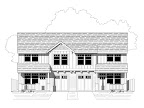We hope that right away you will notice the two-stud corner. Great for eliminating cold pockets. Also shown is a raised-heel truss which allows full insulation to the edge of the roof. Hopefully full blocking will be added before the ceiling is covered.


This project looks it will employ an airtight drywall approach. The interior walls have been set 1" away from the exterior walls so that drywall may pass behind and be continuous. No air leaks here or extra backing required.


Finally, an oddball built-up header. While we laud the use of standard 2x6 lumber and OSB scraps to make a substantial header, this will make for a thermal bridge. If all 3 pieces of 2x6 are needed, we would recommend 2x6,2x6,1" foam,2x6. This would allow for bearing, insulation, and a sturdy surface from whence to hang curtain rods from.
There are several more Habitat projects in our area and we hope to get in on some framing action in the next month or two. In the meantime we will continue to expand our portfolio of small homes. Visit istockhouseplans and see our latest plans, or add this blog into your RSS feed.




